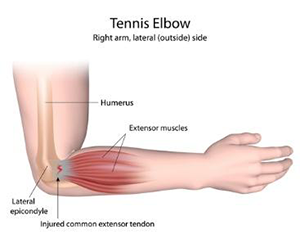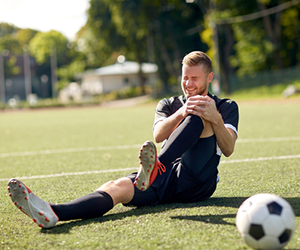Symptoms & Treatment Options for Tennis Elbow in Mokena and Palos Hills

The sun is shining, there’s a warm breeze—it’s time to get out on the tennis court! Do you find yourself with pain, tenderness, and stiffness in your forearm and elbow after enjoying a game of tennis? If so, you may be suffering from lateral epicondylitis, also known as tennis elbow.
Characterized by pain on the outer side of the elbow joint, lateral epicondylitis can develop quickly (acute) or become an issue over time (chronic). Don’t let the fear of injury keep you from your weekly doubles game this spring, but if you find yourself suffering from tennis elbow, here is a guide to help you get on the path to recovery, as well as prevent the injury in the first place.
The elbow joint is comprised of bones, ligaments, muscles and tendons. The wrist flexor muscles, responsible for controlling the wrist and fingers, connect to the elbow via the wrist flexor tendons. Lateral epicondylitis occurs when repetitive motion of the wrist and arm, such as a tennis backhand, causes stress to the muscles, tendons, and ligaments in the elbow joint. The stress is believed to cause tiny tears in the flexor tendons, resulting in pain, inflammation and tenderness.
Symptoms include:
 The elbow joint is comprised of bones, ligaments, muscles and tendons. The wrist flexor muscles, responsible for controlling the wrist and
The elbow joint is comprised of bones, ligaments, muscles and tendons. The wrist flexor muscles, responsible for controlling the wrist and
- Pain on the outer bony area of the elbow
- Pain radiating down the forearm and into the wrists
- Stiffness in the elbow joint and hands
- Weak grip
- Inability to carry objects with injured arm (MidAmerica Orthopaedic - Patient Education)
Pain on the inner portion of the elbow is indicative of a similar condition, medial epicondylitis, also known as golfer’s elbow. If you’re experiencing pain and discomfort on the inner side of the elbow joint, you can learn more about medial epicondylitis here.
Risk Factors
While lateral epicondylitis is colloquially referred to as “tennis elbow”, the condition does not only affect tennis players. Risk factors that increase the chance of developing lateral epicondylitis include:
- Age — the condition usually develops gradually, and is common in individuals ages 30-50, however it is also possible to develop the condition at a younger age.
- Sports — the repetitive motion of the wrists in sports like tennis and other racquet sports can lead to the development of lateral or medial epicondylitis. Poor technique and the wrong racket also contribute to the development of the condition.
- Occupation — despite the name, this condition is not exclusive to athletes. Certain professions have a higher chance of developing lateral epicondylitis. The condition is commonly seen in painters, plumbers, carpenters, and butchers. (Mayo Clinic)

Non-Surgical Treatment
Fortunately, the majority of lateral epicondylitis cases can be treated with non-surgical methods. However, the condition is considered degenerative and if you experience symptoms, you should seek treatment as soon as possible. Treatment usually includes a combination of self-treatment, and work with physical or occupational therapists. If you’re experiencing pain you believe may be caused by lateral epicondylitis, start with some self-care methods such as:
If you continue to experience pain after implementing at-home treatments, it’s time to visit your orthopaedic specialist. Your doctor may recommend non-surgical treatments such as steroid injections to reduce inflammation, platelet-rich plasma (PRP) injections, and working with a physical, or occupational therapist to implement a rehabilitative exercise plan that strengthens and heals the muscles and tendons in the elbow joint. (OrthoInfo)
Surgical Treatment
In most cases, tennis elbow can be effectively treated without resorting to surgery. Surgery is only considered in less common, extreme cases where pain persists after at-home treatment, physical therapy, and other non-surgical treatment methods. Surgery for lateral epicondylitis involves accessing the elbow through a small incision and trimming the tendon or releasing the tendon before reattaching to the elbow bone. The procedure is widely effective and typically outpatient.
As you start to gear up for your spring tennis or racquetball sessions, keep the health of your elbow joint in mind. You can reduce your risk of developing tennis elbow by taking professional lessons to ensure you’re using the proper technique, investing in a midsize racquet and an elbow brace while playing, and being sure to not over exert yourself. (eMedicine Health)

Dr. Gary A. Kronen
If you do develop symptoms of lateral epicondylitis, the orthopaedic specialists at MidAmerica Orthopaedics are ready to help. For special care, turn to Dr. Gary A. Kronen, MidAmerica’s orthopaedic surgeon specializing in hand and upper extremity treatment and surgery. Dr. Kronen is recognized as one of the premier hand surgeons in the United States and believes in a team approach to find the best treatment plans for his patients.
To learn more about MidAmerica Orthopaedics and the different treatment options available to you, visit our website.
To schedule an appointment with MidAmerica Orthopedic Surgeon, Dr. Gary A. Kronen, call (708) 237-7200. You can also request an appointment online.

